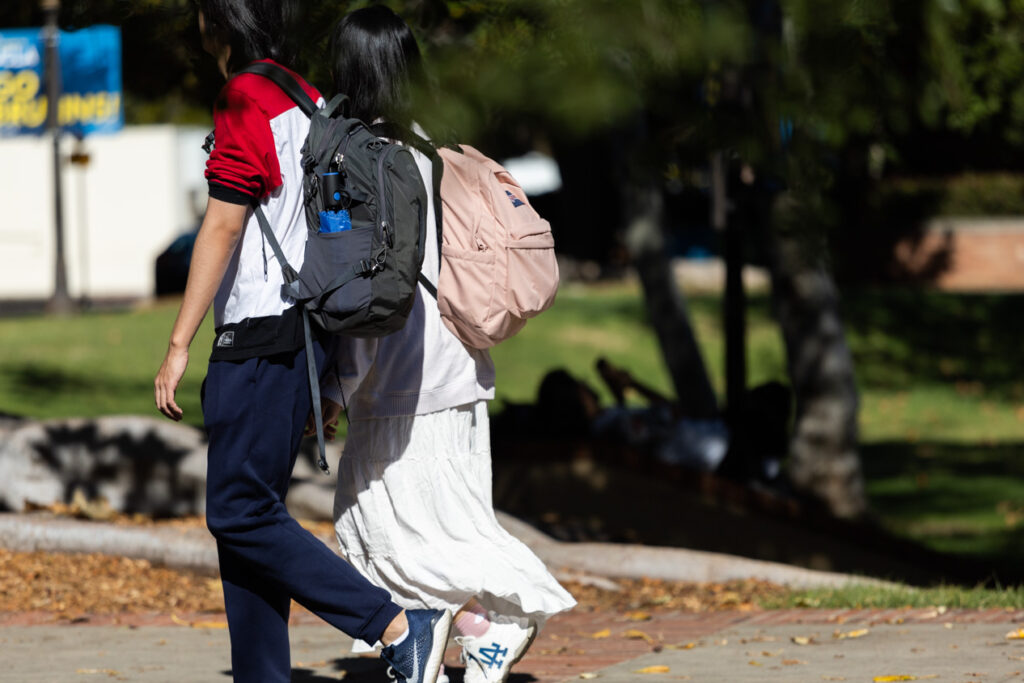
A multi-ethnic group of elementary age children are playing with blocks in class at their desks.
Credit: Christopher Futcher / iStock
Audacious, multimillion dollar scandals by two California charter school operators within the past decade exposed vulnerabilities to fraud resulting from inept and negligent oversight and inadequate auditing. A pair of inquiries into those weaknesses have concluded that several dozen actions could help spot, address and potentially deter future attempts by charter school operators to evade state laws and regulations.
Both reports were issued within the past two months. One is a joint effort of the Legislative Analyst’s Office (LAO) and the Fiscal Crisis Management Assistance Team, a state fiscal oversight agency known as FCMAT.
The other is by the Anti-Fraud Task Force of the California Charter Authorizing Professionals, a nonprofit association for school districts and county offices of education. Its report reminded legislators and policymakers what’s at stake in failures of oversight: “Every theft of funds from our public schools not only harms the students, but also undermines public confidence in our public education system.”
A third and final report, concentrating on auditing reforms, will be released before June 30 by a multi-agency task force. Chaired by state Comptroller Malia Cohen, it was commissioned by San Diego Superior Court Judge Robert Longstreth, who presided over a jaw-dropping case of financial abuse.
That case involved the now-defunct virtual charter school network A3 Education, which thrived because of a total breakdown of accountability systems. Its founders, Sean McManus and Jason Schrock, pleaded guilty in 2021 to a conspiracy to commit theft of public dollars, extracting $400 million in attendance-based state revenue, much of it based on phantom enrollments. They siphoned at least $50 million to a company they owned while promising services to students that were never provided. In return for serving four years on house arrest, the executives pledged to repay $37 million.
A3 operated 19 charter schools approved by small school districts in a half-dozen counties that relied on the 1% to 3% in annual fees to balance their budgets. Collectively, the fees produced millions of dollars. The districts didn’t supervise effectively, because they lacked the capacity, expertise and, in some cases, motivation to hold charter schools accountable.
Big revenue for a tiny district
Among them is Dehesa School District, with 84 students and one school in the San Diego County foothills. It chartered three A3 schools. Dehesa’s former superintendent was the only superintendent of the 11 people indicted in the A3 scandal.
Dehesa also granted charters to two schools for Inspire Charter Schools, the other suspected perpetrator of large-scale fraud. Inspire, a home-school charter network with a dozen schools in multiple counties with, at one point, 24,380 students, directed 15% of its more than $100 million income to a corporation created by its founder, Herbert “Nick” Nichols III.
Inspire enticed families to enroll by awarding $2,600 per student to spend on academic enrichment activities of their choice, including annual passes to Disneyland and Big Air Trampoline Park.
An audit by FCMAT found that the records of financial expenditures and transfers of money from school to school, all run by Nichols’ central office, were so poorly kept and hard to track that FCMAT couldn’t prove fraud or other illegalities — although the deficiencies in recordkeeping increased the likelihood of them, the audit said. Nichols, who received $1,056,000 in advance pay, agreed to pay it back in a severance agreement in 2019 but declined repeated requests to speak with FCMAT, according to the audit.
A3 and Inspire may have committed the largest-scale fraud, but they weren’t the only cases of embezzlement and probably won’t be the last. Last week, Al Muratsuchi, D-Torrance, who chairs the Assembly Education Committee, and Josh Newman, D-Fullerton, who chairs the Senate Education Committee, requested approval of a state audit of a charter school and related operations after whistleblowers told Sacramento TV news channel ABC10 about suspected fraud, waste and abuse of public funds. The audit would include examining oversight of the district authorizer, Twin Rivers Unified.
The employees of Sacramento-based Highlands Community Charter School asserted problems that include falsified student attendance numbers, cronyism and misuse of public funds for luxury gifts for staff and students, staff bonuses, and political contributions. Highlands Community Charter enrolls adult immigrant students for career and technical courses and English language instruction.
Reports by both LAO-FCMAT and the authorizers’ task force make similar recommendations for effective oversight, such as demanding that nonprofit charter school boards scrutinize third-party contracts for conflicts of interest and annual financial audits. In return for authorizers doing more work, the LAO-FCMAT report would raise their fees to 3% of a charter school’s Local Control Funding Formula revenue.
The LAO-FCMAT report calls for limiting small school districts’ ability to authorize charter schools with enrollment no larger than the district’s own. It suggests creating a new entity to approve and oversee all-virtual charter schools, which currently must seek multiple distinct authorizers in many counties, complicating coherent oversight.
The task force calls for establishing a statewide Office of Inspector General, perhaps under the state Attorney General, to investigate and prosecute financial fraud in school districts, community colleges and charter schools. The office would have the power to issue subpoenas and prosecute.
Demand more of charter authorizers
Past attempts to legislate reforms broke down amid contention between school districts and charter schools’ advocates. But David Patterson, a founding member and now president of the California Charter Authorizing Professionals, said he’s optimistic that collaborative work over two years will resolve disagreements.
He said the bulk of recommendations would not require statutory or regulatory changes and could be adopted immediately. They’d involve creating a fraud risk management program for all charter schools and charter management organizations, as well as district and county authorizers. Elements would include regularly training charter school board members and fleshing out expectations and statutory obligations for authorizers which, Patterson acknowledged, are “outmoded and insufficient.” Even some of the small authorizers “that everyone wants to pick on, deservedly so, probably met minimal requirements” under the state’s 30-year-old charter school law, he said.
There also would be clear procedures for filing complaints of suspected fraud, including a statewide hotline, Patterson said. Currently, there are no formal channels for reporting suspected fraud. Jeff Rice, founding director of APLUS+, which advances personalized learning models for 91 member charter schools in California, said he called out Inspire for the Disneyland passes, and others complained to authorizers and county offices about illegal enrollment practices, to no avail, he said.
‘The San Diego County District Attorney’s Office charged A3’s founders and administrators with defrauding the state by inflating tuition revenue by purchasing children’s personal information from private and public schools and then enrolling them without families’ knowledge. FCMAT suspected Inspire did something similar by manipulating enrollments in a multitrack attendance schedule.
Eric Premack, executive director of the Charter Schools Development Center in Sacramento, a veteran charter school adviser and advocate, put the blame on auditors and authorizers for not detecting the fraud.
“Even the smallest authorizer spending 20 minutes in the school could have and should have found this. If it’s a brick-and-mortar school, go visit at least a couple of classrooms,” he said. “And if there’s no students in the classroom and no teaching going on, you know you have a problem. In an independent study program, go in, look at the enrollment list. And then say, ‘I want to see this kid’s work.’”
Both reports suggest improvements in the auditing process.
- Charter school audits are not required to extensively examine enrollment and attendance records. The LAO-FCMAT report would require an auditor to flag for the board and authorizer any monthly variation in enrollment or attendance numbers exceeding 5%.
- Sampling records and transactions for compliance is critical to detecting discrepancies. The standard practice is for the auditor to choose what should be sampled. But the LAO-FCMAT report said that in recent cases of fraud, the school had provided the sample. The report calls for mandating that the auditors choose.
- Charter schools must choose an auditor from a state-sanctioned list. But there’s no requirement that auditors have any expertise in doing school audits. That would change. Auditors on the state list would be required to take regular training in school financing and regulations.
The anti-fraud task force and LAO-FCMAT reports focused on non-classroom-based charters because that’s where cases of fraud, including A3 and Inspire, have largely been concentrated. Non-classroom-based charters are defined as schools in which less than 80% of instruction occurs in a classroom.
Contrary to widespread belief, few of them are strictly online schools, as the LAO and FCMAT discovered. About a quarter of the state’s 1,200 charter schools are non-classroom-based, serving 38% of charter school students. Post-COVID, the combination of hybrid schools and home-based schools that spend part of the week in school facilities is a fast-growing sector of schools. Most report they offer no virtual instruction or are primarily classroom‑based.
Classification as a non-classroom-based charter imposes a set of requirements to qualify for full funding. Class sizes can be no larger than 25 to 1; schools must spend at least 40% of their revenue on certificated teachers and staff and 80% of their budget on instruction.
In a recommendation that surprised and pleased most charter advocates, the LAO-FCMAT report recommends narrowing the definition of non-classroom schools to those offering less than 50% instruction in a classroom. Schools would be able to count facilities expenses as part of instruction, and qualify for after-school funding that other schools receive.
“We question whether a whole bunch of charter schools should have to go through the funding determination process,” said Mike Fine, FCMAT’s CEO. “The name non-classroom-based charter school is a misnomer for many schools that don’t have a virtual component, have a robust facility (operation) and a cost structure that isn’t any different from any other school.”
In 2019, the Legislature imposed a two-year moratorium on passing new non-classroom-based charter schools, and has twice extended it. The moratorium expires in 2026.
Fine said the idea behind the LAO-FCMAT report was to air issues and propose solutions in order to avoid another moratorium extension. “Come next year,” he said, “this will provide a foundation for a starting point of a discussion.”




